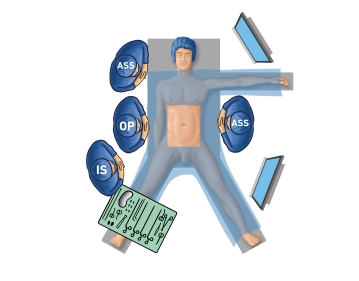Postoperative Analgesia:
Postoperatively, patients receive non-opioids regularly, opioids only as needed.
Follow the link here to PROSPECT (Procedures Specific Postoperative Pain Management).
Follow the link here to the current guideline Treatment of acute perioperative and post-traumatic pain.
Medical Follow-up:
The urinary catheter is removed in the OR, allowing early mobilization of patients (in the evening on the day of surgery). A central line is avoided.
Monitoring in the recovery room immediately postoperatively, then transfer to the general ward.
Thrombosis Prophylaxis:
In the absence of contraindications, due to the moderate thromboembolic risk (surgical procedure > 30 min duration), in addition to physical measures, low molecular weight heparin should be administered prophylactically, possibly in a weight- or risk-adapted dosage until full mobilization is achieved.
Note: Renal function, HIT II (history, platelet monitoring)
Follow the link here to the current guideline Prophylaxis of venous thromboembolism (VTE).
Mobilization:
Early mobilization on the evening of the operation. Gradual resumption of physical activity, full weight-bearing if pain-free.
Physiotherapy:
Breathing exercises
Diet Progression:
Drinking on the day of surgery, soup, yogurt from day 1, light diet from day 2
Bowel Regulation:
Stimulation of bowel activity with parasympathomimetics (e.g., Neostigmine sc. 2x/d)
Discharge:
From the 4th postoperative day; sick leave individually – according to the degree of convalescence
Interdisciplinary Tumor Board to determine further procedures

